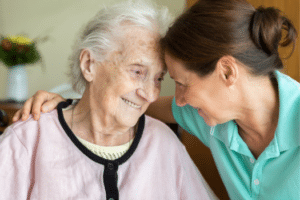With our cell phones and other smart devices always within reach, we’re coming to depend more and more on technology to assist with, and sometimes sadly replace, our human-powered efforts in everyday tasks. Here in the Bay Area, we’re seeing robots being tested out as replacements for the warm companionship of in-person care aging adults deserve, some even replicating the behavior and appearance of pets to keep older adults company.
On the other hand, some robots are offering a dynamic way for older adults to stay in touch with loved ones across the country, or even just across the Bay, enhancing video chats as a robot with a tablet screen follows them around on a wheeled base. As you video chat with your loved one, they can move around the house or even take a walk, and all the while you can rest assured they are happy, healthy, and safe. Beyond just staying in touch, these mobile video systems can even relieve some of the need for caregivers to be with aging adults in person, allowing them to manage the care of more clients throughout the Bay Area at once. But this brings up a crucial question—are we taking the “care” out of caregiving?
When Care Is Systematized
Today, thanks to technological advances, caregivers can automate nearly every aspect of care, from diet regulation to consistent dosages of meds, appointment reminders or even ordering groceries and taking out the trash. The Bay Area’s newest robotic residents can certainly contribute to these straightforward tasks—as well as recognize when older adults are in emergency situations that call for immediate medical attention. But the experiences of belonging, love, and identity cannot be automated. Age does not diminish our need for human connection, socialization, and touch.
In the Bay Area, the population of adults over 65 has been steadily growing. As our aging population grows disproportionately to the twenty-somethings, and the ratio of caregivers to those in need becomes further strained, quality of care and quality of life for older adults are at risk. So, maybe it’s not surprising that 43 percent of older adults report feeling lonely. And the seemingly inevitable automation of care won’t make up for our societal deficit in human connection—arguably exaggerated by our general dependence on digital living.
Robotic Care Cannot Replace True Companionship
As adults age, their hearing and vision can become strained, and the need for human touch is even more vital to creating connection. As individuals begin to lose some of their memories and some of the people they love, they’re at greater risk of becoming isolated. And the trend toward impersonal, robotic care is bound to further the negative effects of disconnection and social isolation, including depression, cognitive decline, and even higher risk of infection.
While technology has an opportunity to play an important role in many aspects of home care in the future, it cannot and will not ever be able to replace the need for in-person care and companionship. Home care is about more than just vitals, medications, and routines. We are entrusted with our clients’ health and happiness because the two are inherently connected.
Let’s explore some of the ways in which direct socialization and human contact can improve quality of care and quality of life for aging adults.
- Nostalgia and Revitalization. Many of the older adults we work with express sadness and longing for the pastimes they used to enjoy and identify with. While they may not be able to get up and dance in the same way they used to, play their instrument with the old band, read the fine print in the newspaper or their favorite book, or take a long hike in the wild, there are ways to bring those interests back to them if we are really willing to engage. We can play music, move with them, read out loud, or go on a walk around the block or just down the driveway.
While the experience may not be exactly the same as they remember, it’s heightened by the presence of someone else engaging in what they love with them. They have an opportunity to share their memories and to really be heard. An iPod may have a collection of their favorite songs and a tablet may allow them to magnify the text of a book, but when we take the time to enjoy it with them, we help bring those pastimes to life.
- Autonomy and Self-Identification. We spend much of our lives serving society and caring for others—in fact, this kind of interaction plays a big role in how a lot of us self-identify. But with age, not only are there fewer opportunities to care for others, there are also more and more ways in which we will need to rely on a caregiver for our basic needs. It’s important that care plans integrate ways for older adults to still make choices for themselves.
Home care robots may allow for more of that independence since they can help to ensure that an aging adult is safe as they go about their daily lives. But it’s important that they have ways to continue to care for others, as well. The Bay Area offers many opportunities for older adults to volunteer in the community, re-engaging them with some of their talents and allowing them to share the wisdom gained from their unique and full lives.
- Intergenerational Connection and Purpose. One thing that characterizes older adults is a wealth of experience. While they may be less able to do some of the activities they’ve loved and that have given them purpose in the past, they still have their stories. They have a unique perspective that comes from a full life lived—it’s not a perspective that the younger generation can reproduce, but it’s one that can enlighten us.
Aging adults have an incredible opportunity to continue to connect to their community with purpose, but it depends on our willingness to engage—to listen and learn from their wisdom and lifelong passions—to put down our own devices and reach out for the gift they are longing to give. We can use technology to record their stories—and even to share with future generations—but it’s our attention here and now that will help to wake up that sense of purpose and belonging in our aging loved ones.
Our human need for connection transcends technology. And IOA’s commitment to progressive and compassionate care is not about our older population alone. It’s about our collective need for purpose. The further we get from personalized care that embraces the psychological and emotional needs of individuals, as well as the practical ones, the further we get from a connected society that grows with experience and wisdom.
Technology offers new and exciting approaches to healthcare, and home care robots can play a big part in supplementing routine care for aging adults. But they won’t eliminate our need to be face to face, hand in hand, in order to experience life fully. As we explore the ways in which we can continue to care for our aging population with compassion, and with the help of technology, we can gain a better understanding of ourselves—and the human experience.
If you’re interested in more ways to connect directly with your aging loved one, Institute on Aging offers resources and programs to help you get involved. Reach out to us now to learn more.







